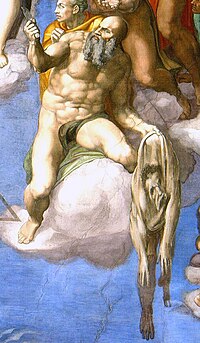Michelangelo The Last Judgement: Fresco by Michelangelo in the Sistine Chapel
The Last Judgment is a fresco by Michelangelo painted on the altar wall of the Sistine Chapel in Vatican City.
Clement VII commissioned the painting in 1534, the last year of his papacy. After the election of Paul III Farnese, Michelangelo, aged 61, began work in 1536. He completed the Last Judgement in the autumn of 1541.


The Last Judgment shows the Second Coming of Christ, as described by John the Evangelist in the apocalypse. The painting depicts the moment when the living and dead are judged by Christ, and their souls consigned to heaven or hell.
The painting was not unanimously admired at the time. Due to his depiction of holy persons in the nude, with exposed genitals, Michelangelo was accused of immorality and obscenity. The cardinal said that this could not be tolerated inside the most important church of Christianity. A censorship campaign was started, known as the "Fig-leaf campaign". Carafa and Monsignor Sernini (Mantua's ambassador) launched the campaign to remove the frescoes. When the Pope's own Master of Ceremonies, Biagio da Cesena, said "it was mostly disgraceful that in so sacred a place there should have been depicted all those nude figures, exposing themselves so shamefully," and that it was no work for a papal chapel but rather "for the public baths and taverns," Michelangelo worked the Cesena's semblance into the scene as Minos, judge of the underworld (far bottom-right corner of the painting). It is said that when Cesena complained to the Pope, the pontiff responded that his jurisdiction did not extend to hell, so the portrait would have to remain.
The genitalia in the fresco were later covered by the artist Daniele da Volterra, whom history remembers by the derogatory nickname "Il Braghettone" ("the breeches-painter").
In the painting, Michelangelo does a self portrait depicting himself as St. Bartholomew after he had been flayed (skinned alive) This is reflective of the feelings of contempt Michelangelo had for being commissioned to paint the Last Judgement.
References
This article uses material from the Wikipedia Simple English article The Last Judgement (Michelangelo), which is released under the Creative Commons Attribution-ShareAlike 3.0 license ("CC BY-SA 3.0"); additional terms may apply (view authors). Content is available under CC BY-SA 4.0 unless otherwise noted. Images, videos and audio are available under their respective licenses.
®Wikipedia is a registered trademark of the Wiki Foundation, Inc. Wiki Simple English (DUHOCTRUNGQUOC.VN) is an independent company and has no affiliation with Wiki Foundation.